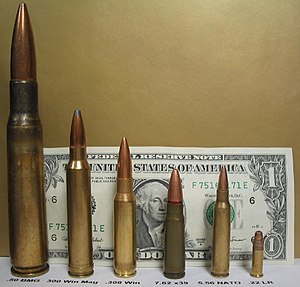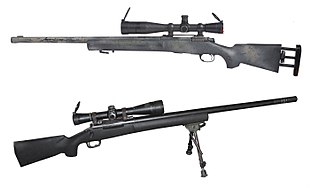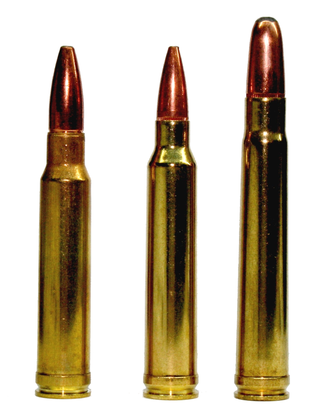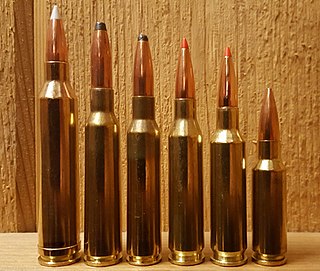This article needs additional citations for verification .(April 2017) |

A rifle cartridge is a firearm cartridge primarily designed and intended for use in a rifle/carbine, or machine gun.
This article needs additional citations for verification .(April 2017) |

A rifle cartridge is a firearm cartridge primarily designed and intended for use in a rifle/carbine, or machine gun.
A full-powered cartridge is a rifle cartridge used interchangeably between service rifles, sniper rifles, and general purpose machine guns. It is a retronym for rifle cartridges used prior to and during World War II. They are primarily used today in general purpose machine guns, designated marksman rifles, and sniper rifles.
A magnum cartridge is a cartridge with a larger case size than, or derived from, a similar cartridge of the same bullet caliber and case shoulder shape. Magnum cartridges allow for more propellant to be loaded within the casing, and thus have a higher muzzle energy. Modern magnum rifle cartridges include .300 RUM, 7mm Remington Magnum, .300 Weatherby Magnum, .460 Weatherby Magnum, .300 Winchester Magnum, .338 Lapua Magnum or .338 Norma Magnum. Today they are primarily used in civilian market for big-game hunting, or as a military ammunition for some long-range sniper rifles.
An intermediate cartridge is a military cartridge that is less powerful than typical full-power cartridges such as the 7.92mm Mauser, .30-06 Springfield, or 7.62×51mm NATO, but still significantly more powerful than handgun cartridges used in service pistols and submachine guns. [1] As their recoil is significantly reduced compared to full-powered cartridges, fully automatic rifles firing intermediate cartridges are relatively easy to control. This reduced recoil impulse also allows for rapid, accurate follow-up shots with semi-automatic rifles or rifles with a semi-automatic fire mode. [2] However, even though less powerful than traditional full-power cartridges, the external and terminal ballistics of an intermediate cartridge are still sufficient for an effective range of 300–600 m (330–660 yd), which are the typical maximum engagement ranges for ordinary infantrymen in modern combat conditions.
The introduction of intermediate cartridges allowed for the development of the assault rifle concept, which is a magazine-fed selective fire rifle lighter and more compact than the conventional battle rifles firing full-powered cartridges. The first intermediate cartridge was the German 7.92×33mm Kurz for the StG 44, [1] the world's first assault rifle. Other examples include the Soviet 7.62×39mm used in the AK-47 and AKM series, the .280 British round developed for the EM-2, and the 5.56×45mm NATO for the AR-15/M16/M4 series rifles.

A carbine is a long gun that has a barrel shortened from its original length. Most modern carbines are rifles that are compact versions of a longer rifle or are rifles chambered for less powerful cartridges.

A sniper rifle is a high-precision, long-range rifle. Requirements include high accuracy, reliability, and mobility, concealment, and optics, for anti-personnel, anti-materiel and surveillance uses by military snipers. The modern sniper rifle is a portable shoulder-fired rifle with either a bolt action or semi-automatic action, fitted with a telescopic sight for extreme accuracy and chambered for a high-ballistic performance centerfire cartridge.

Weatherby, Inc. is an American gun manufacturer founded in 1945 by Roy Weatherby. The company is best known for its high-powered magnum cartridges, such as the .257 Weatherby Magnum, .270 Weatherby Magnum, .300 Weatherby Magnum, .340 Weatherby Magnum and the .460 Weatherby Magnum. The company's headquarters is based in Sheridan, Wyoming.

The .338 Lapua Magnum is a rimless, bottlenecked, centerfire rifle cartridge. It was developed during the 1980s as a high-powered, long-range cartridge for military snipers. It was used in the War in Afghanistan and the Iraq War. As a result of this, it has become widely available.

The .44 Remington Magnum, also known as .44 Magnum or 10.9x33mmR, is a rimmed, large-bore cartridge originally designed for revolvers and quickly adopted for carbines and rifles. Despite the ".44" designation, guns chambered for the .44 Magnum round, its parent case, the .44 Special, and its parent case, the .44 Russian all use 0.429 in (10.9 mm) diameter bullets. The .44 Magnum is based on the .44 Special case but lengthened and loaded to higher pressures for greater velocity and energy.

The .460 Weatherby Magnum is a belted, bottlenecked rifle cartridge, developed by Roy Weatherby in 1957. The cartridge is based on the .378 Weatherby Magnum necked up to accept the .458-inch (11.6 mm) bullet. The original .378 Weatherby Magnum parent case was inspired by the .416 Rigby. The .460 Weatherby Magnum was designed as an African dangerous game rifle cartridge for the hunting of heavy, thick skinned dangerous game.

A designated marksman rifle (DMR) is a modern scoped high-precision rifle used by infantry in the designated marksman (DM) role. It generally fills the engagement range gap between a service rifle and a dedicated sniper rifle, at around 300–600 metres (330–660 yd).
A rim is an external flange that is machined, cast, molded, stamped, or pressed around the bottom of a firearms cartridge. Thus, rimmed cartridges are sometimes called "flanged" cartridges. Almost all cartridges feature an extractor or headspacing rim, in spite of the fact that some cartridges are known as "rimless cartridges". The rim may serve a number of purposes, including providing a lip for the extractor to engage, and sometimes serving to headspace the cartridge.

The .300 Winchester Magnum is a belted, bottlenecked Magnum rifle cartridge that was introduced by the Winchester Repeating Arms Company in 1963. The .300 Winchester Magnum is a magnum cartridge designed to fit in a standard rifle action. It is based on the .375 H&H Magnum, which has been blown out, shortened, and necked down to accept a .30 caliber (7.62 mm) bullet.

The .338 Winchester Magnum is a .338 in (8.6 mm) caliber, belted, rimless, bottlenecked cartridge introduced in 1958 by Winchester Repeating Arms. It is based on the blown-out, shortened .375 H&H Magnum. The .338 in (8.6 mm) is the caliber at which medium-bore cartridges are considered to begin. The .338 Winchester Magnum is the first choice among professional brown bear guides in Alaska to back up clients where a powerful stopping caliber is required on charging bears. It is also the most popular medium-bore cartridge in North America and has the most widely available choice in rifles among medium bore rifles. The action length is the same as a .30-06, and most major rifle manufacturers in the United States chamber rifles for the cartridge including the semi-automatic Browning BAR Mk II Safari, making it a very powerful combination against charging dangerous game. The cartridge was intended for larger North American big-game species and has found use as for the hunting of thin-skinned African plains-game species.

Elmer Merrifield Keith was an American rancher, firearms enthusiast, and author. Keith was instrumental in the development of the first magnum revolver cartridge, the .357 Magnum (1935), as well as the later .44 Magnum (1956) and .41 Magnum (1964) cartridges, credited by Roy G. Jinks as "the father of big bore handgunning." Keith was born in Hardin, Missouri, and overcame serious injuries that he had sustained at age 12 in a fire when he was living in Missoula, Montana.
The Whisper family of firearm cartridges is a group of wildcat cartridges developed in the early 1990s by J.D. Jones of SSK Industries. The Whisper Family was developed as a line of accurate, multi-purpose cartridges using relatively heavy rifle bullets for a given caliber in subsonic loads. The intention was to create an extremely accurate cartridge family for military, police, competition and specialized hunting markets that could also be easily sound suppressed.
The .300 Remington Ultra Magnum, also known as the .300 Ultra Mag, 7.62×72mm or .300 RUM, is a 7.62 mm rifle cartridge introduced by Remington Arms in 1999. The .300 Remington Ultra Magnum is one of the largest commercially available .30 caliber magnums currently being produced. It is a beltless, rebated rim cartridge, capable of handling all large North American game, as well as long-range shooting. Among commercially produced .30-caliber rifle chamberings, the .300 Remington Ultra Magnum is second only to the .30-378 Weatherby Magnum in cartridge-case capacity.

An intermediate cartridge is a rifle/carbine cartridge that has significantly greater power than a pistol cartridge but still has a reduced muzzle energy compared to fully powered cartridges, and therefore is regarded as being "intermediate" between traditional rifle and handgun cartridges.

The 6.5mm Creedmoor (6.5×48 mm), designated 6.5 Creedmoor by SAAMI, 6.5 Creedmoor by the C.I.P. or 6.5 CM or 6.5 CRDMR for short, is a centerfire rifle cartridge introduced by Hornady in 2007. It was developed by Hornady senior ballistics scientist Dave Emary in partnership with Dennis DeMille, the vice-president of product development at Creedmoor Sports, hence the name. The cartridge is a necked-down modification of the .30 Thompson Center.

The .338 Norma Magnum is a cartridge first introduced in 2008 and came into production in 2009, designed by Norma of Sweden.

Varmint rifle is an English term for a small-caliber precision firearm or high-powered airgun primarily used for both varmint hunting and pest control. These tasks include killing three types of pests or nuisance animals that spread diseases or destroy crops or livestock:
The .500 S&W Magnum or 12.7×41mmSR is a .50 caliber semi-rimmed revolver cartridge developed by Cor-Bon in partnership with the Smith & Wesson "X-Gun" engineering team for use in the Smith & Wesson Model 500 X-frame revolver and introduced in February 2003 at the SHOT Show. From its inception, it was intended to be the most powerful handgun cartridge to date, with the capacity to harvest all North American game species. While more powerful handgun cartridges, such as the .500 Bushwhacker, have emerged since, they are only available in custom firearms, and the .500 S&W remains the most powerful production handgun cartridge.

A fully powered cartridge, also called full-power cartridge or full-size cartridge, is an umbrella term describing any rifle cartridge that emphasizes ballistic performance and single-shot accuracy, with little or no thought to its weight or recoil. They often have a caliber comparable to or greater than 7.5 mm (0.30 in) and a maximum effective range of at least 800 m (870 yd), and are intended for engaging targets beyond 300 m (330 yd). However, cartridges with calibers as narrow as 6.5mm have been described as full-power. The term generally refers to traditional cartridges used in machine guns and bolt action and semi-automatic service rifles and select fire battle rifles prior to, during, and immediately after the World Wars and the early Cold War era, and was a retronym originally made to differentiate from intermediate cartridges that gained widespread adoption into military service after World War II.